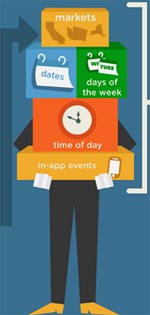Commentary
Placed Analytics Finds Mobile Often Really Means 'Mobile'
- by Steve Smith , Staff Writer @popeyesm, August 30, 2012
 Finding users while they are “on the go” has become a tired promise of mobile marketing since its early days. Truth is, “mobile” very often means
“at home” or “at work” but consulting a second screen. Except when people really are in motion.
Finding users while they are “on the go” has become a tired promise of mobile marketing since its early days. Truth is, “mobile” very often means
“at home” or “at work” but consulting a second screen. Except when people really are in motion.
“A third of all app interactions occur when people are walking or in transit,” says Placed founder and CEO David Shim. His local analytics company helps app developers, and now mobile Web sites, detect the location profile of the places that users open and use their mobile resources. The young company has already surpassed 1 billion measured location calls, and is discovering some interesting characteristics of the mobile lifestyle.
Mobile sometimes really means “mobile.” While 63.85% of app opens occur when the user is staying in one place, 16.61% are happening when they are in a vehicle of some kind and 17.56% occur while the user is walking. The user profile in terms of motion actually can be different from city to city. In a market like Atlanta, Shim tells us, 40% of the app opens they measured are occurring in transit.
Placed also discovered that almost a third -- or 28.23% to be exact -- of app opens were occurring near some food and beverage outlets, while almost as many (27.34%) were opened near a restaurant. The affinity of mobile use to shopping is also evident here, with 26.35% of app look-ups occurring near a shopping venue.
When it comes to specific brands, it is not surprising that 6.15% of the time an app is being used near a fast food outlet, it is close to Starbucks, or 5.93% of the time near a McDonald’s, or 5.78% of the time near a Subway. When app users were near a department store, more than 20% of the time they were near a Walmart or a Target.
One of the most striking and surprising findings after a billion location-profile hits is how apps have their own location characteristics. “Apps have very distinct place profiles, or the places that people are when consuming the content,” he says. Even two weather apps can have different place profiles. Placed was designed mainly to help app developers and publishers understand the contexts in which their content was seen so they can shape the experience to the setting. Publishers can determine whether their app is being used near specific venues and business types more often than others.
Placed surpassed the 1 billion milestone, as it also expands its reach beyond apps. The company is launching a similar location analytics service for mobile sites this week. Placed also added to its advisory board a familiar figure from the digital and mobile marketing world, Jeff Lanctot, global CMO, Razorfish.
Placed’s figures remind us that one of the most hotly contested and debated areas of content and ad targeting on mobile will be what “context” means. A decade ago the early behavioral marketers squabbled over what online activities signaled “intent” and defined a person as “in-market.” Consider that stuff elementary compared to the ways in which mobile media expands the idea of content to consider not only time and place, but specific location. And how about likely mood of the user? Isn’t mode of use a part of the context as well?
Early behavioral targeting defined context as what content you happened to be near. Now it is about where you are, how you got there, when you are there, what you probably are doing, what you just did, etc. Holy crap! Marketing now has to adapt to life as we live it, not just interrupt the specific occasions and places that mass media defined for us in the last century.



